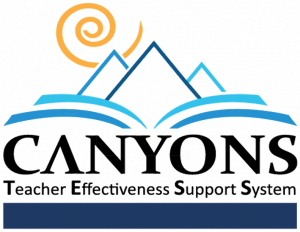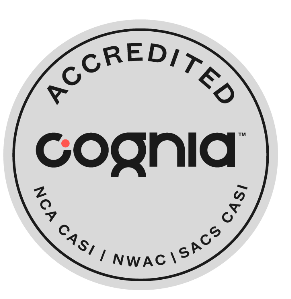Canyons Teacher Effectiveness Support System

In 2012, the Utah Legislature passed Senate Bill 64, specifying that teacher evaluation must include:
1. documentation of student growth,
2. evidence of instructional quality, and
3. response to stakeholder input.
This new law required that the District establish a new evaluation process for teachers and administrators. In fall of 2013 the District’s Joint Education Evaluation Committee (JEEC) established the following priorities for a new evaluation system that complies with state law:
- Create a growth plan for all teachers, recognizing that in a teacher’s first years they will perform at different levels and rates.
- Ensure that mentoring and coaching for all teachers offer multiple opportunities for public practice, feedback, and self-reflection.
- Use multiple reliable and valid measures to make conclusions about a teacher’s potential to be effective throughout their career.
- Address the importance of a teacher’s willingness to apply feedback by incorporating improvement strategies and supports in the district’s educator effectiveness process.
In the 2014-15 school year teachers participated in an operational field test of the Canyons Teacher Effectiveness Support System (CTESS). Through this process teachers implemented team and individual learning goals while receiving ongoing feedback about classroom techniques and contributions to teamwork. Feedback was collected from teachers and admnistrators and many adjustments were made to the system. In the 2015-16 school year, full implementation was begun with teachers placed in one of three phases in order to comply with state law and afford our teachers the feedback and support they deserve.
The purpose of evaluation in Canyons is to prioritize professional growth and support for all educators, retain and promote effective educators, and ensure that every student receives high-quality instruction every day. With this purpose, the Canyons Teacher Effectiveness Support System (CTESS) has been developed to increase feedback to educators about instruction and increase the use of public practice applications by Canyons professional educators.
The Utah State Office of Education has assigned to following weightings to the three components of educator evaluation for the state:
- Assessment of Instructional Quality – 70%
- Evidence of Student Growth – 20%
- Response to Stakeholder Input – 10%
These weighting percentages are used to determine the final rating of Ineffective, Emerging/Minimally Effective, Effective, or Highly Effective.
The Utah state law requires that every career educator be evaluated once a year and every provisional educator be evaluated twice each year.
- For career educators, the rating they receive in Phase One of the CTESS cycle remains in place for the next two years, unless there are performance concerns.
- Provisional teachers will be in Phase 1 of the CTESS cycle for 3 yeras. The rating they receive in the first cycle in Phase 1 will provide the feedback and access to coaching support needed to increase performance on any skills that are found to be deficit. Teachers will have time to work on these skills prior to the next cycle of evaluation in Phase 1. The rating they recieve in the second cycle of evaluation is their final rating for the year. Provisional teachers will complete 2 cycles in each of their three provisional years. The following graphic shows the phases and cycles of the CTESS system. Provisional teachers remain in Phase 1 for three years:
CTESS is grounded in 12 standards developed by aligning the 2012_USOE_Teacher_Standards.pdf and the Canyons Academic Framework to Support Effective Instruction. The CTESS Standards represent the essential ingredients for high quality instruction that defines teacher effectiveness. For organizational purposes, the standards have been grouped into four domains. This graphic shows the 12 standards in 4 domains:
CTESS_Domains_and_Standards.docx.pdf
Nationally, school districts have been scrambling to adhere to state and federal mandates that define teacher evaluation. The Canyons District’s Joint Educator Evaluation Committee (JEEC), which includes principals, teachers, and parents (4 of each), studied current policy, research, and reported data about educator evaluation from around the country to made recommendations. These recommendations were then translated into observation protocols and planning templates. All administrators, and many teachers and coaches, participated in piloting of the protocols and templates to provide feedback that lead to numerous improvements to the system.
Teacher surveys have provided a wealth of information and continue to guide refinements to CTESS. Administrators provide feedback to the administrator over evaluation development on an ongoing basis. It is anticipated that refinements will continue to be made in the 2015-16, 2016-17, and 2017-18 school years. These changes are made in order to increase support and decrease complexity of the system to achieve the goal of providing Canyons teachers with the support they need to be effective educators. Remediation and support, not dismissal, is the goal of CTESS. Educators who are willing to improve their practice based on the feedback they recieve will be offered coaching support to help them achieve their goals. CTESS was developed with this in mind.
The CTESS process includes:
- A yearly self-assessment – teachers develop yearly team and individual goals based on each school’s Continuous School Improvement Plan.
- Classroom observations – All teachers will be observed while instructing each year using the Instructional Priorities Observation Protocol (IPOP).
- Career teachers in Phase One will be observed twice (minimum).
- Career teachers in Phase Two and Three will be observed once (minimum) each year.
- Provisional teachers will be observed four times (minimum) in each of their three provisional years.
- Documentation of lesson planning (Lesson Plan Template), effective classroom practices (IPOP), collaboration and teaming (Meeting Participation Checklist).
- Response to Stakeholder Input – each year, educators will analyze their survey data from students and parents and write an action statement.
- Student Growth – the Utah State Office of Education will generate a student growth percentile for each teacher based on SAGE scores or Student Learning Objectives.
- Growth and Support – The process is focused on growth and provides educators with actionable feedback. If an educator receives a lower rating on a standard, they will receive specific feedback on how to increase their effectiveness in that standard. Coaches are available in every school to assist teachers in their improvement efforts.
Following state recommendations there are three ways that student growth will be measured. For tested subjects and grades, the SAGE assessment and median student growth percentile, or MSGP, will be utilized. Tested subjects and grades include:
- English language arts grades 3-11
- Math grades 3-8 along with Secondary Math I, II, and III
- Science grades 4-8 plus Biology, Chemistry, and Physics.
For untested subjects and grades, educators will measure student growth through Student Learning Objectives (SLOs) or Rate of Improvement (ROI). For more information on these measures of student growth please view screencasts 4) Student Growth Part 2 and 5) Stakeholder Input.
Research indicates that well crafted student surveys are reliable and valid predictors of student achievement and valuable sources of feedback to improve teaching. During Spring 2014 many teachers in Canyons volunteered to pilot student surveys. After receiving feedback from teachers, administrators, and students, separate surveys for early elementary, upper elementary, and secondary students were finalized. Each survey has been statistically analyzed to ensure its reliability and validity. The process for collecting surveys has not yet been finalized.

